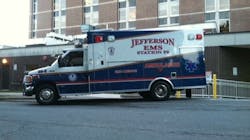SCRANTON — The president of the relief association of the Jefferson Twp. Volunteer Ambulance Association detailed the close working relationship between the township’s volunteer ambulance and fire companies Friday as the group made its case for a share of state funds distributed annually by the township.
Daniel Corallo, who is in his second year as head of the association, was among seven witnesses who testified during a sometimes contentious four-hour hearing before Lackawanna County Judge James Gibbons.
At issue is thousands of dollars allocated each year through the state auditor general’s office that the township previously split evenly between the relief associations of the ambulance association and the Jefferson Twp. Volunteer Fire Company to support their activities.
The ambulance group, which contends the township now plans to give all the money to the Fire Department, asked the court in a complaint filed last month to order the Board of Supervisors to follow past practice and distribute the money evenly between the two associations.
Funds frozen for now
Gibbons, who has ordered the funds frozen while the matter is pending, did not indicate how quickly he will rule.
His decision is expected to hinge in large part on whether there is an affiliation between the ambulance relief association and the fire company.
Under questioning by association attorney James Mulligan, Corallo cited as evidence of an affiliation the fact that ambulance crews respond with township firefighters to every fire call, motor vehicle crash and hazmat incident and provide treatment at the scene to any firefighter who requires it.
He testified his review of a dispatch log Mulligan obtained from the county 9-1-1 center showed the ambulance company was dispatched on more than 200 calls with the Fire Department between January 2017 and this month.
Corallo also testified about a number of instances when ambulance personnel treated or performed evaluations of firefighters at incident scenes.
Mulligan also questioned Corallo about a May 2017 letter from the fire company that laid out its “expectations” of the ambulance association when responding to calls. Among other things, the letter said ambulance personnel may not leave a scene until released by the fire company, Corallo said.
Documentation focus
Township solicitor Anthony Magnotta, who during his questioning of witnesses repeatedly returned to the lack of any documented proof of an affiliation, asked Corallo if he had provided anything to the supervisors to document that an affiliation existed.
“In my opinion, it’s all right here,” Corallo said, indicating the 9-1-1 logs.
Corallo, who testified the ambulance association’s support of the fire company is explicitly stated in its recently amended bylaws, was unaware the ambulance relief association has its own separate bylaws until presented with a copy by Magnotta.
Corallo acknowledged those bylaws do not contain the same language.
Two former supervisors, Paul Thomas and Lester Butler Jr., testified about the township’s rationale for splitting the state funds evenly in the past, with both saying the ambulance and fire companies responded to the same emergencies.
Under cross-examination by attorney Ernie Preate Jr., who is representing the fire company, the former supervisors said they didn’t investigate further.
“They did things together. ... I think that’s enough,” Thomas testified.
Fire Chief Donald Wallace testified his department has no written agreements with the ambulance association and said there is no affiliation between the groups. The May 2017 letter was written after an ambulance prematurely left the scene of a hazmat incident and was intended to be “instructive,” Wallace said.
The auditor general distributes the state funding to municipalities for disbursement to volunteer firefighter relief associations to help pay for training, equipment and insurance, as well as death benefits for firefighters. The money comes from a 2 percent tax on premiums paid for casualty and fire insurance sold in the state by out-of-state insurance companies.
Jefferson Twp.’s allocation generally has ranged between $20,000 and $25,000 annually since 2012.
———
©2019 The Times-Tribune (Scranton, Pa.)
Visit The Times-Tribune (Scranton, Pa.) at thetimes-tribune.com
Distributed by Tribune Content Agency, LLC.






